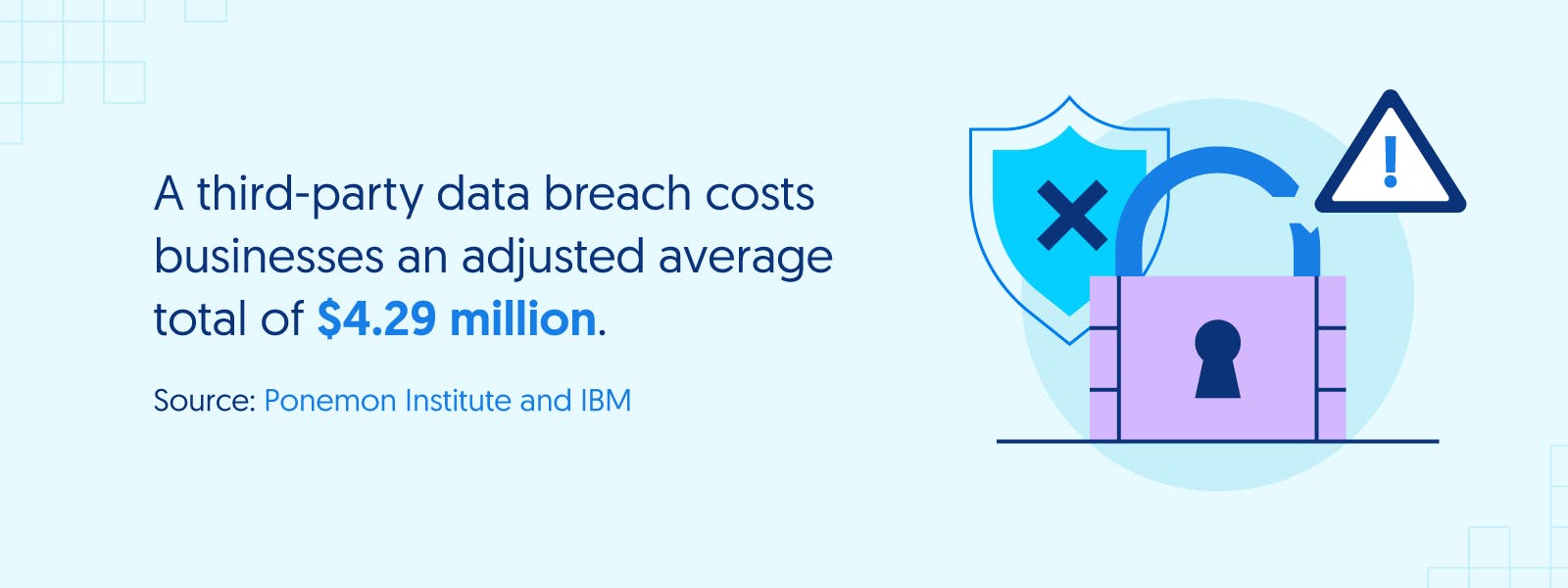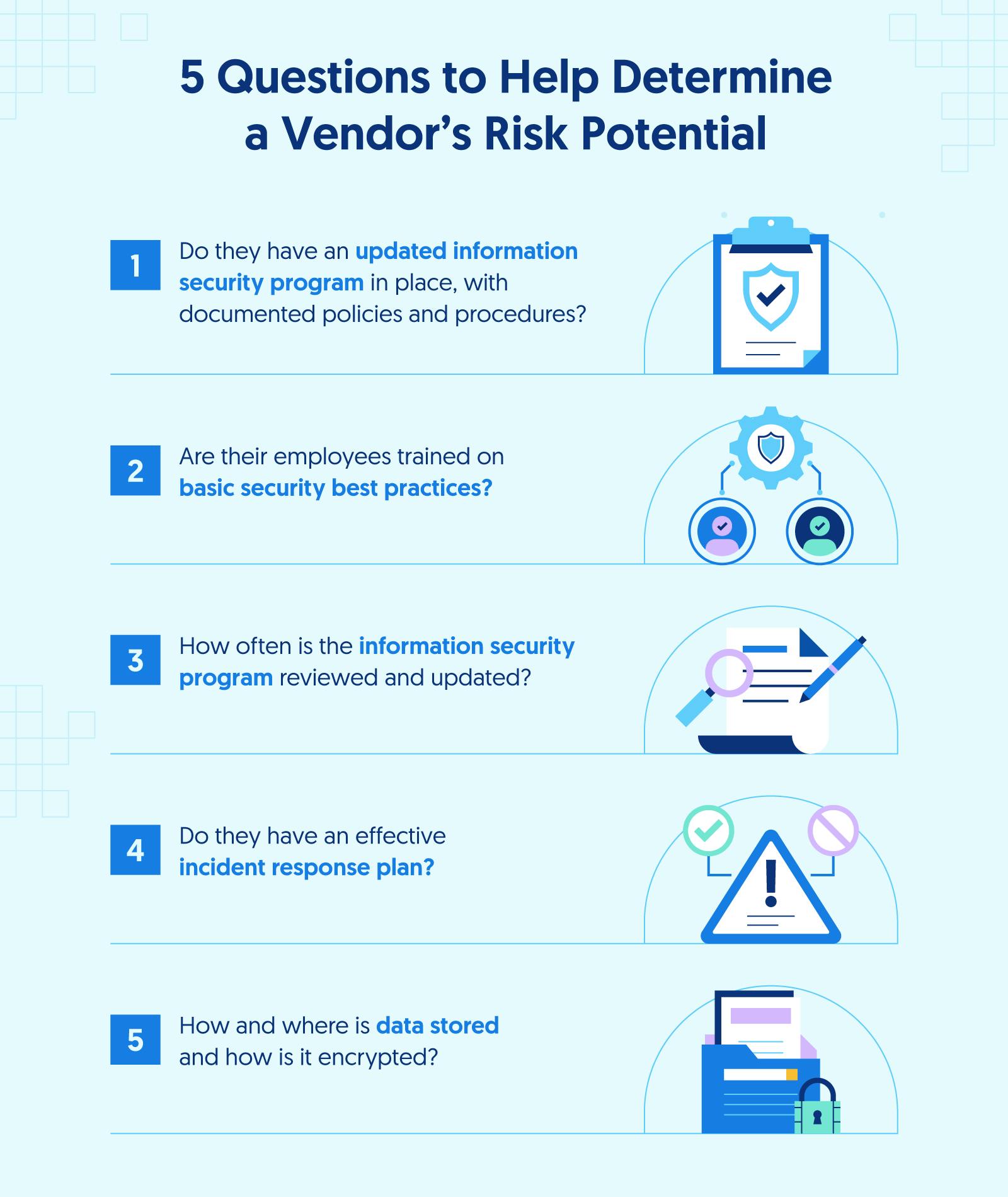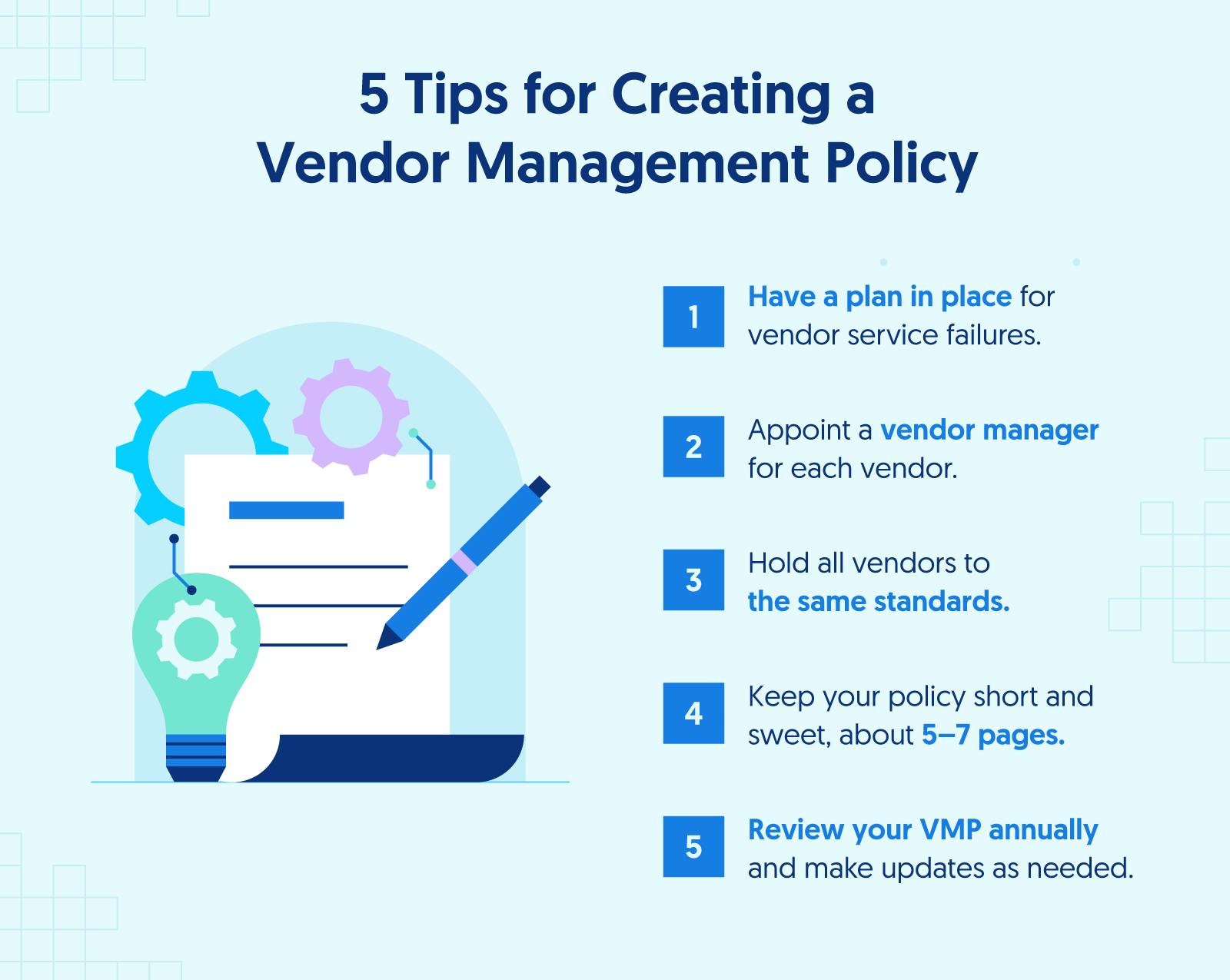
Senior Content Marketing Manager at Secureframe
Senior Compliance Manager at Secureframe
A vendor management policy (VMP) is a way for companies to identify and prioritize vendors that pose a risk to their business. The policy identifies potentially risky vendors and prescribes controls to minimize risk and ensure compliance with popular frameworks like SOC 2.
Vendor management policies are a critical component of an organization’s overall compliance risk management strategy.
You may be quick to think of a VMP as just another document or a box to be checked on your path to compliance. But a vendor management policy is just the start of managing vendor relationships and determining whether they should have access to sensitive data.
Ready to find out how a vendor management policy can safeguard your organization against vendor risk? We break down how to create one and offer a template to get you started below.
While organizations tend to have a clear picture of the internal risks their business faces, the risks that come from vendors can be a bit murkier.
Regulatory bodies have begun to step in and implement stricter protocols regarding vendor oversight and third-party risk management. A 2022 Venminder report found that 69% of organizations feel they’ve been getting more scrutiny over the last 12 months by regulators and auditors.
The more vendors you work with and share sensitive information with, the more exposed your organization is to hackers. And when a third party is involved, data breaches tend to cost more.
A study by Ponemon Institute and IBM found that the cost of a third-party data breach increases by over $370,000, for an adjusted average total cost of $4.29 million.

Whether you work with just one vendor or dozens, not having a vendor management policy puts your organization in a vulnerable position.
To begin creating a vendor management policy, you must first put together a team to spearhead the policy creation process.
This should be a comprehensive team that brings together different viewpoints from across the organization.
Here are team members to consider including:
Once you’ve assembled your vendor management policy team, assign roles and responsibilities to own different sections of the process.
Next, gather your list of vendors. This should be an in-depth list containing all third-party vendors, contractors, partners, and associates that you work with.

Pay special attention to those vendors that:
The vendors that meet any of the above criteria should be considered critical vendors because of the level of information they can access.
This master list will serve as a blueprint to help you prioritize vendors based on the risk they pose.
There’s no one-size-fits-all approach for creating a vendor management policy.
Each organization comes with its own unique set of vendors and information to protect.
Whether you’re creating a vendor management policy for the first time or looking to strengthen your current policy, here are a few sections that will help build a solid foundation for managing vendor relationships.
The purpose section of your VMP is an overview of what the policy will entail. You can think of this as a thesis statement introducing the many sections that will follow.
Here’s an example of what a purpose statement could look like:
The audience and scope sections will define whom exactly the policy applies to. This is where the careful consideration in creating the master list of vendors comes in handy.
Doing your due diligence in identifying your vendors helps ensure that none fall through the cracks and that you are able to appropriately monitor and track every vendor that poses a risk.
A few vendor areas to consider including in your vendor management policy are:
Each person that plays a significant role in your vendor management process should be included within the VMP. Include their specific responsibilities as it relates to vendor management.
Outline each role within your organization that handles key vendor management duties, such as a vendor manager. List the specific responsibilities under each role within this section.
Some key aspects to include are:
List and define some of the common terms used within the policy. This is an opportunity to establish common terminology that will be easily understood by anyone who may need to review your vendor management policy.
For example, you may want to clearly define what a vendor is or the type of data you’ll be referring to within the document.
However, remember that your vendor management policy should be a high-level document that’s meant to outline in basic but broad terms how the organization will conduct third-party management.
The assessments section should include all of the ways vendors will be vetted before becoming fully operational.
While this section will look different for each company, many organizations include information about:
This section will explain the management processes the organization will follow to ensure vendors are assessed and held accountable.
Within this section, be sure to specify what vendor agreements and contracts must include.
For example, you may want to include verbiage about minimum information requirements, instructions for the destruction or disposal of the organization’s information, and incident response requirements.
This section should also detail the vendor lifecycle management process. Include information for onboarding a new vendor as well as managing and offboarding current vendors.
After stating all vendor requirements, you must also include a section of how the policy is going to be enforced.
This section should clearly state the consequences a vendor will face if they fail to follow the policy. This may include termination of contract, removal of access rights, or related civil or criminal penalties.
Before signing a contract with a potential new vendor, organizations can rate vendors against vendor management controls to determine a security rating.
That rating can be used to determine if the organization should work with the vendor. It can also serve as a benchmark to evaluate security performance over time.

Vendor management policies will differ from organization to organization. However, here are a few important tips to keep in mind as you create or improve your vendor management policy:
Still unsure of what your vendor management policy should look like? We’ve created a template that you can use as a foundation for building your own.

Continuous monitoring is a must for vendor management programs, but it can be a burdensome undertaking for your team.
Tools like Secureframe help companies automatically monitor and rate their vendors’ security performance and automate security questionnaires that make the vendor management process all the more manageable.
With Secureframe, you’ll have access to auditor-certified security questionnaires to help vet potential vendors seamlessly. Secureframe also offers up-to-date security reports of each vendor with risk levels and in-depth descriptions.
Looking to safeguard your vendor relationships and better manage your security? Schedule a demo with our team today to see how we can fit your exact needs.